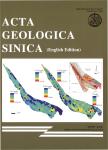Late Cenozoic Sedimentary Evolution of Pagri-Duoqing Co graben, Southern End of Yadong-Gulu Rift, Southern Tibet
Late Cenozoic Sedimentary Evolution of Pagri-Duoqing Co graben,Southern End of Yadong-Gulu Rift, Southern Tibet作者机构:Key Laboratory of Neotectonic Movement & Geohazards Ministry of Natural Resources Institute of Geomechanics Chinese Academy of Geological Sciences Beijing 100081 China Chinese Academy of Geological Sciences Beijing 10003 7 China College of Earth Science and Resources China University of Geosciences Beijing 100083 China
出 版 物:《Acta Geologica Sinica(English Edition)》 (地质学报(英文版))
年 卷 期:2018年第92卷第3期
页 面:972-987页
核心收录:
学科分类:070903[理学-古生物学与地层学(含:古人类学)] 0709[理学-地质学] 0819[工学-矿业工程] 081803[工学-地质工程] 07[理学] 08[工学] 0818[工学-地质资源与地质工程] 0708[理学-地球物理学] 0816[工学-测绘科学与技术]
基 金:supported by National Natural foundation of China (grants No. 41571013) China Geology Survey project (grants No. DD20160268)
主 题:north trending rifts initial rifting age Late Cenozoic strata sedimentary evolution OSL ESR and paleomagnetic dating Tibet China
摘 要:The north trending rifts in southern Tibet represent the E-W extension of the plateau and confirming the initial rifting age is key to the study of mechanics of these rifts. Pagri-Duoqing Co graben is located at southern end of Yadong-Gulu rift, where the late Cenozoic sediments is predominately composed of fluvio-lacustrine and moraine. Based on the sedimentary composition and structures, the fluviolacustrine could be divided into three facies, namely, lacustrine, lacustrine fan delta and alluvial fan. The presence of paleo-currents and conglomerate components and the provenance of the strata around the graben indicate that it was Tethys Himalaya and High Himalaya. Electron spin resonance(ESR) dating and paleo-magnetic dating suggest that the age of the strata ranges from ca. 1.2 Ma to ca. 8 Ma. Optically stimulated luminescence(OSL) dating showed that moraine in the graben mainly developed from around181-109 ka(late Middle Pleistocene). Combining previous data about the Late Cenozoic strata in other basins, it is suggested that 8-15 Ma may be the initial rifting time. Together with sediment distribution and drainage system, the sedimentary evolution of Pagri could be divided into four stages. The graben rifted at around 15-8 Ma due to the eastern graben-boundary fault resulting in the appearance of a *** by a geologically quiet period about 8-2.5 Ma, the paleolake expanded from east to west at around 8-6 Ma reaching its maximum at ca. 6 Ma. Then, the graben was broken at about 2.5 Ma. At last,the development of the glacier separated the graben into two parts that were Pagri and Duoqing Co since the later stages of the Middle Pleistocene. The evolution process suggested that the former three stages were related to the tectonic movement, which determined the basement of the graben, while the last stage may have been influenced by glacial activity caused by climate change.



